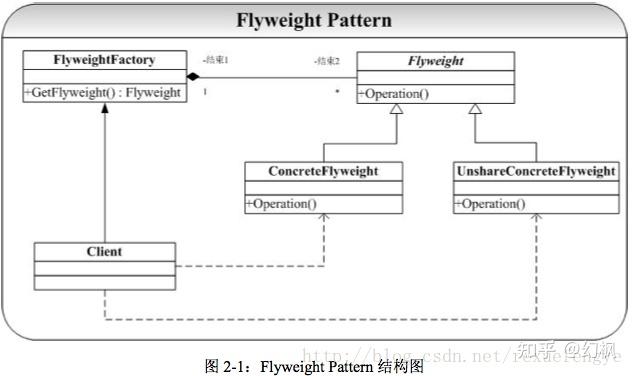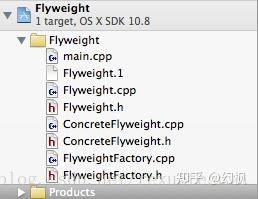|
|
一、描述
设计模式中的享元模式,避免大量拥有相同内容的小类的开销(如耗费内存),使大家共享一个类(元类).
问题
在面向对象系统的设计何实现中,创建对象是最为常见的操作。这里面就有一个问题:如果一个应用程序使用了太多的对象,就会造成很大的存储开销。特别是对于大量轻量级(细粒度)的对象,比如在文档编辑器的设计过程中,我们如果为没有字母创建一个对象的话,系统可能会因为大量的对象而造成存储开销的浪费。例如一个字母“a”在文档中出现了100000 次,而实际上我们可以让这一万个字母“a”共享一个对象,当然因为在不同的位置可能字母“a”有不同的显示效果(例如字体和大小等设置不同),在这种情况我们可以为将对象的状态分为“外部状态”和“内部状态”,将可以被共享(不会变化)的状态作为内部状态存储在对象中,而外部对象(例如上面提到的字体、大小等)我们可以在适当的时候将外部对象最为参数传递给对象(例如在显示的时候,将字体、大小等信息传递给对象)。
其典型的结构图为:

图 2-1
可以从图 2-1 中看出,Flyweight 模式中有一个类似 Factory 模式的对象构造工厂
FlyweightFactory,当客户程序员(Client)需要一个对象时候就会向 FlyweightFactory 发出请求对象的消息 GetFlyweight()消息,FlyweightFactory 拥有一个管理、存储对象的“仓库”(或者叫对象池,vector 实现),GetFlyweight()消息会遍历对象池中的对象,如果已经存在则直接返回给 Client,否则创建一个新的对象返回给 Client。当然可能也有不想被共享的对象(例如结构图中的 UnshareConcreteFlyweight),但不在本模式的讲解范围,故在实现中不给出。
二、实例
如上所描述的信息,创建类图:

本人的工程目录:

注释:
main:客户程序员(Client)
FlyweightFactory:“仓库”(对象池),
Flyweight:对象池中的对象
ConcreteFlyweight:被共享的对象
代码:
仓库”(对象池):FlyweightFactory类
FlyweightFactory.h
#ifndef __Flyweight__FlyweightFactory__
#define __Flyweight__FlyweightFactory__
#include <iostream>
#include &#34;Flyweight.h&#34;
#include <string>
#include <vector>
#include &#34;ConcreteFlyweight.h&#34;
using std::cout;
using std::endl;
using std::string;
using std::vector;
class FlyweightFactory
{
public:
FlyweightFactory();
~FlyweightFactory();
Flyweight* GetFlyweight(const string &key);
private:
vector<Flyweight*> _fly;
};
#endif /* defined(__Flyweight__FlyweightFactory__) */
FlyweightFactory.cpp
#include &#34;FlyweightFactory.h&#34;
FlyweightFactory::FlyweightFactory()
{
}
FlyweightFactory::~FlyweightFactory()
{
}
Flyweight* FlyweightFactory::GetFlyweight(const string &key)
{
vector<Flyweight*>::iterator it = _fly.begin();
for (; it != _fly.end(); it++)
{
if ((*it)->GetIntrinsicState() == key)
{
cout<<&#34;already created by users....&#34;<<endl;
return *it;
}
}
Flyweight *fn = new ConcreteFlyweight(key);
_fly.push_back(fn);
return fn;
}
对象池中的对象:Flyweight类
Flyweight.h
#ifndef __Flyweight__Flyweight__
#define __Flyweight__Flyweight__
#include <iostream>
#include <string>
using std::string;
class Flyweight
{
public:
Flyweight(void);
virtual ~Flyweight(void);
virtual void Operation(const string& extrinsicState);
string GetIntrinsicState();
protected:
Flyweight(string intrinsicState);
private:
string _intrinsicState;
};
#endif /* defined(__Flyweight__Flyweight__) */
Flyweight.cpp
#include &#34;Flyweight.h&#34;
Flyweight::Flyweight(void)
{
}
Flyweight::Flyweight(string intrinsicState)
{
this->_intrinsicState = intrinsicState;
}
Flyweight::~Flyweight()
{
}
void Flyweight::Operation(const string &extrinsicState)
{
}
string Flyweight::GetIntrinsicState()
{
return this->_intrinsicState;
}
被共享的对象:ConcreteFlyweight
ConcreteFlyweight.h
#ifndef __Flyweight__ConcreteFlyweight__
#define __Flyweight__ConcreteFlyweight__
#include <iostream>
#include &#34;Flyweight.h&#34;
class ConcreteFlyweight:public Flyweight
{
public:
ConcreteFlyweight(void);
ConcreteFlyweight(string intrinsicState);
~ConcreteFlyweight();
void Operation(const string& extrinsicState);
};
#endif /* defined(__Flyweight__ConcreteFlyweight__) */
ConcreteFlyweight.cpp
#include &#34;ConcreteFlyweight.h&#34;
using std::cout;
using std::endl;
ConcreteFlyweight::ConcreteFlyweight(void)
{
}
ConcreteFlyweight::ConcreteFlyweight(string intrinsicState)
{
cout<<&#34;ConcreteFlyweight Build.....&#34;<<intrinsicState<<endl;
}
ConcreteFlyweight::~ConcreteFlyweight()
{
}
void ConcreteFlyweight::Operation(const string &extrinsicState)
{
cout<<&#34;ConcreteFlyweight:内蕴[&#34;<<this->GetIntrinsicState()<<&#34;] 外 蕴[&#34;<<extrinsicState<<&#34;]&#34;<<endl;
}
客户程序员(Client)
main.cpp
#include <iostream>
#include &#34;Flyweight.h&#34;
#include &#34;ConcreteFlyweight.h&#34;
#include &#34;FlyweightFactory.h&#34;
using namespace std;
int main(int argc, const char * argv[])
{
FlyweightFactory *fc = new FlyweightFactory();
Flyweight* fw1 = fc->GetFlyweight(&#34;hello&#34;);
Flyweight* fw2 = fc->GetFlyweight(&#34;world!&#34;);
Flyweight* fw3 = fc->GetFlyweight(&#34;hello2&#34;);
// insert code here...
std::cout << &#34;Hello, World!\n&#34;;
return 0;
}
结果如下:

参考文献:《GoF_23种设计模式解析》 |
|